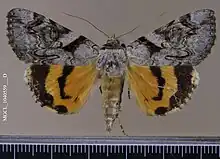| Three-staff underwing | |
|---|---|
 | |
| Scientific classification | |
| Domain: | Eukaryota |
| Kingdom: | Animalia |
| Phylum: | Arthropoda |
| Class: | Insecta |
| Order: | Lepidoptera |
| Superfamily: | Noctuoidea |
| Family: | Erebidae |
| Genus: | Catocala |
| Species: | C. amestris |
| Binomial name | |
| Catocala amestris | |
| Synonyms | |
| |
Catocala amestris, the three-staff underwing, is a species of Catocalini that occurs in North America. It is considered endangered and is legally protected in the state of Michigan.[3]
Description
Like most underwings, C. amestris has a brightly colored hindwing and brownish-gray forewings, the wingspan is 1.6-1.8in (4-4.5 cm). The forewings have a blotch that strongly resembles a kidney shape, beyond that the wing has mixed wavy lines. The hindwings have two wavy black lines separating a yellow-orange coloration. The caterpillar of this species is bluish white with a yellowish coloring on the dorsum, or top side. It also has an orange band along with 7 thin black lines on its sides.[4]
Habitat
Between June and August this moth can be seen in dry-mesic prairie lands and oak forest. Due to only having one host plant, Amorpha canescens, the moth is hard to find in even these areas.
References
- ↑ Yu, Dicky Sick Ki. "Catocala amestris Strecker 1874". Home of Ichneumonoidea. Taxapad. Archived from the original on July 7, 2015.
- ↑ "Moth Photographers Group Catocala amestris - 8844". Retrieved 2009-06-11.
- ↑ "Species Catocala amestris - Three-staff Underwing - Hoges#8844 - BugGuide". Retrieved 2009-06-11.
- ↑ "Catocala amestris (Three-staff underwing) - MNFL Rare Species Explorer". Archived from the original on 2009-01-05. Retrieved 2009-06-11.